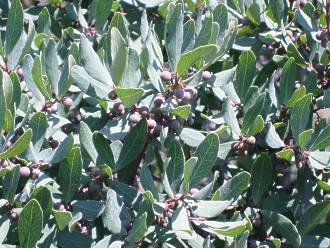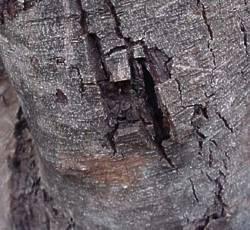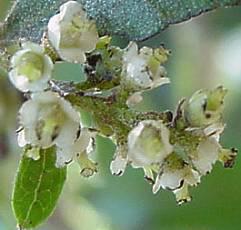Euclea crispa
Euclea crispa (Thunb.) Gürke subsp. crispa
Family: Ebenaceae
Common names: blue guarri (Eng.); bloughwarrie (Afr.); iyeza-lokuxaxazisa, umgwali (isiXhosa), motlhaletsogane (Setswana); idungamuzi, umgwali (isiZulu), gwari (Pedi)
SA Tree No: 594
Introduction
The blue guarri is a nea, well-shaped tree ideally suited to smaller gardens.

Description
Description
Euclea crispa is a single-stemmed small tree with many smaller branches forming a dense crown reaching a height of 2-6 metres and a spread of 2-4 metres.
The bark varies from grey and smooth when young to dark brown and rougher with age; it is often covered in lichen. The young growth usually has rusty brown glands which disappear with age. The leaves are small; blue to grey and variable in shape. They are smooth and leathery to the touch.

Whitish green to yellow bell-shaped flowers are produced from spring to summer, October to February; they attract bees with their sweet scent. The male and female flowers are on separate trees.

A single-seeded fruit ripens from reddish brown to black. They are palatable to humans and eaten by birds and mammals.
Conservation Status
Status
The blue guarri is not threatened and its red-list status is Least Concern (LC).
Distribution and habitat
Distribution description
This evergreen tree is indigenous to southern Africa and has a wide natural distribution range from the Eastern Cape, up the KwaZulu-Natal coast and further northwards past South Africa's northern border.
Occurs in bushveld, sheltered places in grassland, forest margins and often in rocky places on both north- and south-facing slopes. Once established they are drought- and frost-resistant, and will grow in full sun and partly shady conditions.
Derivation of name and historical aspects
History
The genus name Euclea from the Greek word eukleia meaning glory and fame, referring to the fine ebony-like wood of some species. Crispa refers to the wavy edges of the leaves.
The genus Euclea belongs to the Ebony Family which is represented in South Africa by 35 species, all slow-growing trees or shrubs. The genus Euclea is a slow growing member of the Ebony Family together with 35 other tree species in South Africa. Euclea is native to Africa, up to Arabia and the Comoro Islands.
Ecology
Ecology
The sweetly scented flowers are visited by bees. The seeds attract many species of birds, antelope and vervet monkeys in the wild. Black rhino have been seen to enjoy browsing the leaves and bark of Euclea crispa.
Uses
Use
Worldwide, several species are used for timber, producing a hard, dark heartwood timber similar to ebony. Euclea pseudebenus from western southern and tropical Africa is known as black ebony but the typical commercial ebony is derived from a species of the related genus Diospyros, namely D. ebenum, which is found in India and Sri Lanka.
The tough leathery leaves are fire-resistant, and fresh branches are used to beat out veld fires. Fruit edible. The chewed ends of the twigs serve as toothbrushes. Medicinally an infusion of the root is taken orally as a remedy for diabetes; also to prevent rheumatism and epilepsy.
The roots yield a dark brown dye when boiled which is used economically to colour wool, mats and baskets.
Growing Euclea crispa
Grow
In nature, the blue guarri grows quite easily from fresh seed as this is its natural way to spread. It must be noted that only female trees produce seed.
During autumn collect your seeds from healthy trees which are disease-free. Remove the thin fleshy seed covering. The seed should be plump, not shrunken and light. Aim to sow as soon as possible after harvesting. Fill a 10 cm deep seedling tray with a mix of rich soil and compost. Ensure the soil is level by pressing down fairly firmly, then place the seeds on top. Cover the seeds with a layer of river sand to a depth of 5 mm. The tray should be kept moist during germination, but never wet. Transplant the seedlings into black nursery bags when they are at the second leaf stage. These slow-growing seedlings will need to be protected from strong winds and frost during their first two years.
This evergreen tree will provide year-round shade to your garden; the large canopy provides homes and a food source to birds and other wildlife as well as providing a sweet scent from the flowers in spring and summer.
Acknowledgements: Phakamani Xaba & Mkhipheni Ngwenya of SANBI for clarification on the isiZulu common names used for Euclea crispa. Marie Jordaan of SANBI for assisting with photos.
References
- Coates Palgrave, M. 2002. Keith Coates Palgrave Trees of southern Africa, edn 3. Struik, Cape Town.
- Goldblatt, P. & Manning, J. 2000. Cape plants: a conspectus of the Cape Flora of South Africa. Strelitzia 9. National Botanical Institute, Pretoria and Missouri Botanical Garden Press.
- Raimondo, D., Von Staden, L., Foden, W., Victor, J.E., Helme, N.A., Turner, R.C., Kamundi, D.A. & Manyama, P.A. (eds). 2009. Red List of South African plants. Strelitzia 25. South African National Biodiversity Institute, Pretoria.
- Van Wyk, B.-E. & Gericke, N. 2000. People's plants: a guide to useful plants of southern Africa. Briza Publications, Pretoria.
- Van Wyk, A.E. (Braam) & Van Wyk, P. 1997. Field guide to trees of southern Africa. Struik, Cape Town.
- Website: Cunliff, J and Teicher, U, 2005. Botanical names and their meanings. http://www.biosciencecommunications.dk/botanical/
Credits
Nicolette Stoll
Millennium Seed Bank Project, Kirstenbosch National Botanical Garden
August 2010
Plant Attributes:
Plant Type: Shrub, Tree
SA Distribution: Eastern Cape, KwaZulu-Natal
Soil type: Sandy, Loam
Flowering season: Early Summer, Late Summer
PH: Acid, Neutral
Flower colour: Green, White, Yellow
Aspect: Full Sun, Morning Sun (Semi Shade), Afternoon Sun (Semi Shade)
Gardening skill: Easy
Special Features:
Horticultural zones











Rate this article
Article well written and informative
Rate this plant
Is this an interesting plant?
Login to add your Comment
Back to topNot registered yet? Click here to register.